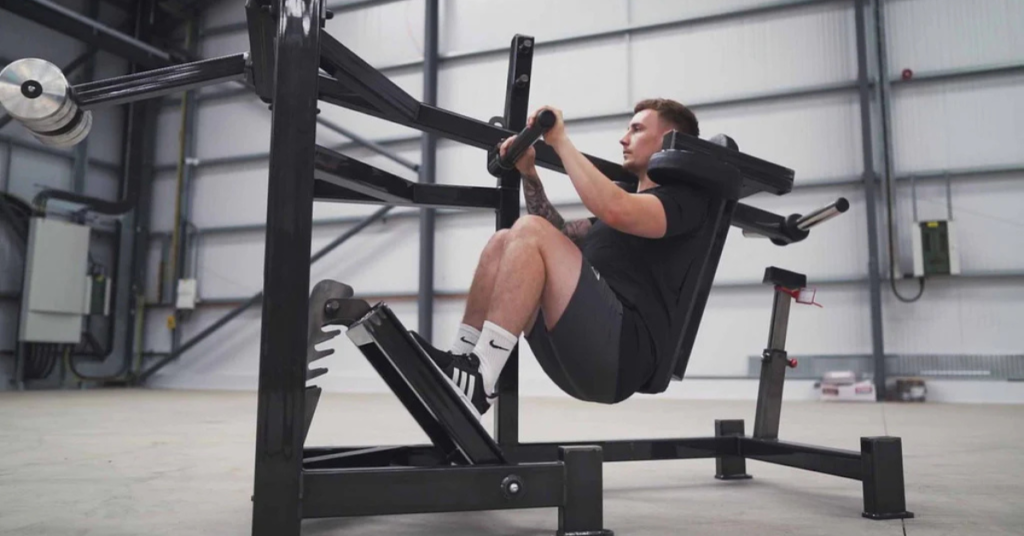In the realm of fitness, variety is key to breaking plateaus and achieving well-rounded muscle growth. Squats are a fundamental movement for building strength and size in the lower body, targeting muscles like the quadriceps, glutes, hamstrings, adductors, and calves. Among the different squat variations available, the pendulum squat stands out due to its unique design and biomechanical advantage. This machine-assisted exercise allows for an arched, pendulum-like motion that takes your squats to a new level.
The pendulum squat machine is a relatively newer addition to many gyms, and while it might look intimidating at first, it offers significant benefits, especially for those looking to target their quadriceps, glutes, adductors, and calves. In this article, we will explore the mechanics, benefits, technique, muscle engagement, common mistakes, and programming tips for incorporating the pendulum squat into your workout routine.
What Is a Pendulum Squat?
The pendulum squat is a machine-based squat variation that features a counterbalanced mechanism. This counterbalance helps guide the user through an arched squatting motion, mimicking the swinging movement of a pendulum. Unlike traditional free-weight squats, which require a high degree of balance and core stability, the pendulum squat machine provides additional support, enabling you to focus more intensely on the target muscles.
The machine typically includes a footplate where the user plants their feet, and a back pad that supports the upper body. The handlebar allows for grip stability, while the counterbalance mechanism ensures a smoother descent and ascent in the squat, reducing stress on the lower back and knees. This makes it an ideal option for lifters who want to safely add volume to their lower body workouts.
How Does the Pendulum Squat Work?
The pendulum squat machine operates on the principle of guided resistance. The machine’s pendulum-like motion ensures that the load is distributed more evenly throughout the entire range of motion. This arched path differs from the straight vertical line of a traditional barbell squat, engaging the muscles in a different manner and putting less strain on the joints, particularly the knees and lower back.
Arched Motion: The main feature of the pendulum squat is its arched motion, which guides the lifter into a deep squat and allows for a more natural and joint-friendly movement. This range of motion enhances quadriceps engagement while simultaneously protecting the knees.
Counterbalance: The counterbalance assists in maintaining control throughout the movement, especially during the eccentric (lowering) phase. This assistance helps reduce the risk of injury and fatigue, making it accessible for users of varying experience levels.
Foot Positioning: The adjustable footplate allows you to modify foot positioning to either increase quad activation (narrow stance) or target the glutes and adductors more (wide stance). This versatility makes the pendulum squat effective for hitting different muscle groups in the lower body.
Benefits of the Pendulum Squat
The pendulum squat offers several advantages over traditional squat variations. These benefits are particularly useful for lifters who are either looking to target specific muscles or are dealing with mobility or injury limitations.
Increased Quadriceps Activation
Because of the machine’s arched motion and counterbalance, the pendulum squat emphasizes quadriceps recruitment. The movement encourages a deep range of motion, which places the quads under significant tension throughout the exercise. This makes it one of the best exercises for building mass and strength in the quadriceps.
Lower Back and Knee Protection
One of the most significant advantages of the pendulum squat is the reduced load on the lower back and knees compared to traditional barbell squats. The machine’s design allows you to maintain a more upright torso, decreasing shear forces on the lower spine. The guided motion also provides joint support, which is particularly beneficial for individuals with knee issues.
Improved Glute Engagement
Although the pendulum squat is primarily a quadriceps-focused exercise, the glutes are also heavily activated, especially during the ascent. By adjusting your foot placement, you can shift the emphasis to the glutes and hamstrings, making this exercise versatile for targeting both the front and rear of the legs.
Better Muscle Isolation
The machine-assisted nature of the pendulum squat allows for better muscle isolation compared to free-weight squats. With less demand on stabilizer muscles, you can focus on the primary target muscles, ensuring maximal activation in the quads, glutes, and adductors. This makes it a useful tool for hypertrophy (muscle building) as well as rehabilitation.
Safe for High Volume Training
Because the pendulum squat reduces stress on the joints and spine, it’s an ideal exercise for high-volume training. Lifters can use heavier loads or perform more repetitions without risking overuse injuries, which is particularly useful during strength-building phases or when training for hypertrophy.
Proper Technique and Execution
To maximize the benefits of the pendulum squat and minimize the risk of injury, it’s essential to follow proper form. Here’s a step-by-step guide on how to perform the pendulum squat correctly.
Step 1: Set Up the Machine
Adjust the footplate: Begin by adjusting the footplate to ensure you have a stable footing. If you’re aiming to target your quads, position your feet slightly narrower. For more glute activation, position your feet wider and slightly higher on the plate.
Back support: Adjust the back pad so it supports your upper back comfortably.
Load the machine: Select an appropriate weight for your fitness level. It’s best to start lighter to practice the motion before increasing the load.
Step 2: Position Yourself
Step onto the footplate and press your back firmly against the pad.
Grab the handlebars for support and stabilization.
Keep your feet shoulder-width apart or slightly wider, depending on which muscles you want to emphasize.
Step 3: Descend (Eccentric Phase)
Inhale and begin the lowering phase by bending your knees and hips, allowing the machine to guide you through the arched motion.
Descend into a deep squat while keeping your chest upright and your back pressed against the pad.
Lower yourself until your thighs are at least parallel to the ground, or deeper if your flexibility allows.
Step 4: Ascend (Concentric Phase)
Exhale as you drive through your heels to push yourself back up to the starting position.
Focus on squeezing your quadriceps and glutes as you ascend.
Keep the motion controlled, and avoid locking out your knees at the top of the movement to maintain tension in your muscles.
Step 5: Repeat
Perform the desired number of repetitions, maintaining proper form throughout.
Common Mistakes to Avoid
Although the pendulum squat machine provides a guided path, improper form can still lead to reduced effectiveness and an increased risk of injury. Here are some common mistakes to watch out for:
Incomplete Range of Motion
One of the main benefits of the pendulum squat is its ability to facilitate a deep squat. Avoid cutting the range of motion short by stopping too high. Lowering yourself deep into the squat ensures that your quadriceps and glutes are fully activated.
Improper Foot Placement
Foot placement plays a critical role in targeting the right muscles. Placing your feet too high or too low can shift the emphasis away from your intended muscle group. Experiment with different positions to find the best stance for your goals.
Overloading the Machine
Although the pendulum squat can handle heavy loads, starting with too much weight can compromise form and increase the risk of injury. Always begin with a manageable weight, and gradually increase as you become more comfortable with the movement.
Neglecting Core Engagement
While the pendulum squat reduces the demand on stabilizer muscles, it’s still important to engage your core throughout the movement to maintain stability and support your lower back.
Muscles Worked in the Pendulum Squat
The pendulum squat is a compound movement, meaning it engages multiple muscle groups. The primary muscles worked include:
Quadriceps: The quads are the primary movers in the pendulum squat, particularly during the ascent.
Glutes: The gluteus maximus is heavily engaged as you extend your hips during the movement.
Adductors: The inner thigh muscles (adductors) are also activated, especially when performing the movement with a wider stance.
Calves: The calves work to stabilize your lower body during the movement, particularly during the ascent.
Core: Although not a primary focus, the core muscles assist in stabilizing the body throughout the exercise.
Incorporating Pendulum Squats into Your Routine
The pendulum squat can be incorporated into your workout routine in several ways, depending on your goals. Here are a few programming options:
As a Primary Lower Body Exercise
For those focusing on building size and strength in the lower body, the pendulum squat can be used as a primary squat variation in your workout. Aim for 3–4 sets of 8–12 reps using moderate to heavy weights.
As an Accessory Movement
If you’re using traditional barbell squats as your main lift, the pendulum squat can serve as an accessory movement to further target your quads and glutes. In this case, use lighter weights and higher reps (12–15) for 3–4 sets.
For Hypertrophy Training
For those focused on muscle growth, the pendulum squat is ideal for performing high-volume sets. Aim for 4–5 sets of 10–15 reps with a focus on maintaining continuous tension throughout the movement.
Conclusion
The pendulum squat is an excellent addition to any lower body workout routine. Its unique arched motion, counterbalance support, and muscle-targeting versatility make it a valuable tool for building size and strength in the quads, glutes, adductors, and calves. Whether you’re looking to break through a plateau, rehabilitate from injury, or simply add variety to your training regimen, the pendulum squat offers a safe and effective solution for lifters of all levels.
By mastering the proper technique, avoiding common mistakes, and strategically programming the pendulum squat into your routine, you’ll be well on your way to achieving your strength and hypertrophy goals.







